List of firsts in aviation
This is a list of outright firsts in aviation. For a comprehensive list of women's records, see Women in aviation.
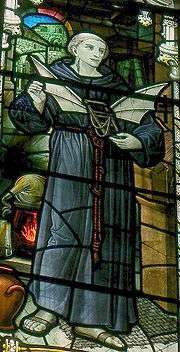
1920 Stained glass window of the monk Eilmer of Malmesbury holding his wings
First person to fly
The first flight (including gliding) by a person is unknown. Several have been suggested.
- In 559 A.D., several prisoners of Emperor Wenxuan of Northern Qi, including Yuan Huangtou of Ye, were said to have been forced to launch themselves from a tower attached to a kite, as an experiment. Only Yuan Huangtou survived, only to be executed later.[notes 1]
- In the 9th century, Abbas ibn Firnas is reported to have attempted flight with wings and feathers.
- In the early 11th century, Eilmer of Malmesbury, an English Benedictine monk, attempted a gliding flight using wings. He is recorded as travelling a modest distance before breaking his legs on landing.[1]
- Hezarfen Ahmed Çelebi is said to have glided over the Bosphorus strait from the Galata Tower to Uskudar district in Istanbul between 1630–1632.[2][3]
- In 1633 his brother Lagari Hasan Çelebi may have survived a flight on a 7-winged rocket powered by gunpowder from Sarayburnu, the point below Topkapı Palace in Istanbul.[4][5]
None of these historical accounts are adequately supported by corroborating evidence or have been widely accepted. The first confirmed human flight was accomplished by Jean-François Pilâtre de Rozier in a tethered Montgolfier balloon in 1783.
Lighter than air (aerostats)
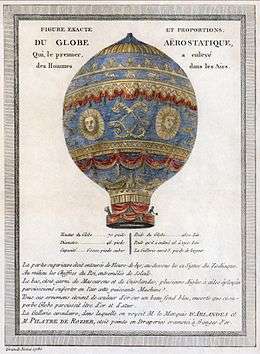
Contemporary drawing of the Montgolfier hot air balloon that made the first confirmed flight by man
- First manned flight Jean-François Pilâtre de Rozier went aloft in a tethered Montgolfier hot air balloon on October 15, 1783.[6]
- First manned free flight in an untethered balloon Jean-François Pilâtre de Rozier and Marquis d'Arlandes flew in a Montgolfier hot air balloon from the Château de la Muette to the Butte-aux-Cailles, Paris, on November 21, 1783.[7][8]
- First manned gas balloon flight: Professor Jacques Charles and Nicolas-Louis Robert flew from Paris to Nesles-la-Vallée in a hydrogen-filled balloon on December 1, 1783.[9]
- First women to fly: The Marchioness and Countess of Montalembert, the Countess of Podenas and Miss de Lagarde ascended in a tethered balloon over Paris, on May 20, 1784.
- First woman in free flight in an untethered balloon: Élisabeth Thible flew over Lyon singing arias on June 4, 1784, in order to entertain Gustav III of Sweden.[10]
- First flight in a steerable balloon (or airship): On July 15, 1784, the Robert brothers (Les Frères Robert) flew for 45 minutes from Saint-Cloud to Meudon with M. Collin-Hullin and Louis Philippe II, the Duke of Chartres, in their elongated balloon. The steerable craft, designed by Jacques Charles, followed Jean Baptiste Meusnier's proposals (1783–85) for a dirigible balloon, with a rudder, but the use of oars as a means of propulsion was not successful.[9]
- First flight across the English Channel: Jean-Pierre Blanchard and John Jeffries crossed the Channel in a balloon on January 7, 1785.[11]
- First aviation disaster: On May 10, 1785, the town of Tullamore, County Offaly, Ireland, was seriously damaged when the crash of a hot air balloon resulted in a fire that burned down about 100 houses.[12]
- First known fatalities in an air crash: Jean-François Pilâtre de Rozier and Pierre Romain died when their Rozière balloon deflated and crashed to the ground near Wimereux in the Pas-de-Calais, on June 15, 1785.[13]
- First jump from a balloon with a parachute: Jean-Pierre Blanchard used a parachute in 1793 to escape his hot air balloon when it ruptured.
- First successful jump from a balloon with a parachute: Andre Jacques Garnerin in Paris in 1797.[14]
- First woman to jump from a balloon with a parachute: Jeanne Geneviève Labrosse jumped from an altitude of 900 m (3,000 ft) on October 12, 1799.
- First woman to pilot her own balloon: Sophie Blanchard flew solo from the garden of the Cloister of the Jacobins in Toulouse on August 18, 1805.
- First woman to be killed in an aviation accident: Sophie Blanchard was killed when her hydrogen-filled balloon caught fire and crashed to the ground on July 6, 1819.[15]
- First successful steerable powered balloon: The Giffard dirigible was invented by Henri Giffard, who piloted it from the Hippodrome in Paris to Trappes on September 24, 1852.[16]
- First balloon mail service: Paris used balloons to pass vital information over Prussian lines during the five-month Siege of Paris in 1870–71.[17]
- First tethered balloon for passengers: Developed by Henri Giffard in the Tuileries Garden, Paris, in 1878.[18]
- First flight in an airship powered by an internal combustion engine: Alberto Santos Dumont, 1898.[19]
- First flight of a rigid airship: Theodor Kober and Ferdinand von Zeppelin's LZ 1 first flew from the Bodensee on July 2, 1900, using a set of seventeen, hydrogen-filled internal gas cells for lift within a light metal structure and powered with a pair of Daimler inline-4 engines of 14 hp (10 kW) each.
- First woman to pilot a powered aircraft: Rose Isabel Spencer, in Stanley Spencer's Airship Number 1, at Crystal Palace, London on July 14, 1902.[20][21]
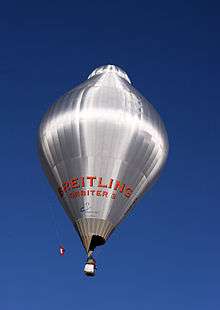
The Breitling Orbiter 3 in which the first non-stop balloon circumnavigation was achieved in 1999
- First trans-Atlantic rigid airship flight: The British rigid airship R34 made the first trans-Atlantic flight by a rigid airship from July 2 to July 6, 1919, in a westerly direction from her base at RAF East Fortune to Mineola, New York, the first-ever east–west trans-Atlantic aircraft flight of any type.[22][23]
- First people to reach the stratosphere: Auguste Piccard and Paul Kipfer ascended to the height of 51,000 ft (15,500 m) in a hydrogen-filled balloon over Augsburg, Germany, on May 27, 1931.[24]
- First crossing of the Atlantic by balloon: Ben Abruzzo, Maxie Anderson, and Larry Newman in the helium-filled Double Eagle II, on August 17, 1978.
- First non-stop balloon crossing of North America: Maxie and Kris Anderson in the helium-filled Kitty Hawk, on May 12, 1980.[25]
- First trans-Pacific crossing by balloon: Ben Abruzzo, Larry Newman, Ron Clark and Rocky Aoki, in gas-filled Double Eagle V, in November 1981.
- First non-stop balloon crossing of the Australian continent: Dick Smith and co-pilot John Wallington in a Cameron-R77 Rozière balloon, the Australian Geographic Flyer,[26] on June 18, 1993.[27]
- First trans-Pacific solo flight in a balloon: Steve Fossett flew in a helium balloon from Seoul, South Korea, to Leader, Saskatchewan, Canada, on February 21, 1995.[28]
- First non-stop balloon flight around the Earth: Bertrand Piccard and Brian Jones flew from Château d'Oex, Switzerland, to Egypt, on board the balloon Breitling Orbiter 3, between March 1 and March 21, 1999, taking a total time of 19 days, 21 hours and 47 minutes.[29]
- First east-west crossing of the Tasman Sea by balloon: Dick Smith and co-pilot John Wallington, against generally prevailing winds, in February 2000.[30]
- First solo non-stop balloon flight around the Earth: Steve Fossett, in the 10-story high balloon Spirit of Freedom, circumnavigated the globe between June 19 and July 3, 2002.[31]
Heavier than air
Pioneer era 1853–1916
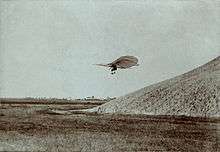
Otto Lilienthal in mid-flight, c. 1895
- First manned glider flight: In 1853, an unnamed boy rode as passenger in an uncontrolled glider flown by George Cayley.[32][33]
- First controlled manned glider flight: Otto Lilienthal, in 1891.[34]
- First controlled, sustained flight in a powered airplane: The Wright brothers are widely regarded as the inventors of the first fixed-wing aircraft to achieve sustained, controlled flight, the Wright Flyer. Orville Wright made the first successful flight in this aircraft on December 17, 1903, travelling 37 m (120 ft) at a speed of 10.9 km/h (6.8 mph).[35]
- First circular flight by a powered airplane: Wilbur Wright flew 1,240 m (4,080 ft) in about a minute and a half on September 20, 1904.[36]
- First aircraft to use ailerons for lateral control: Robert Esnault-Pelterie's October 1904 glider used ailerons, although they were only given that name in 1908 by Henry Farman.[37]
- First heavier-than-air flight of more than 25 m (82 ft) in Europe: On October 23, 1906, Alberto Santos-Dumont, flew a distance of 60 m (200 ft) in his 14-bis at the Chateau de Bagatelle, Paris, winning the Archdeacon Prize.[38]
- First flight certified and registered by Fédération Aéronautique Internationale (FAI): On November 12, 1906, in the presence of official observers from the newly founded FAI, Alberto Santos Dumont flew his 14-bis a distance of 220 m (720 ft) at the Chateau de Bagatelle, Paris.[39]
- First airplane passenger: Léon Delagrange, with pilot Henri Farman, on March 29, 1908.[40]
- First use of the modern aircraft flight control system: Originally devised by French aviator Robert Esnault-Pelterie, in April 1908 Louis Blériot's Blériot VIII first took to the air with Esnault-Pelterie's control layout, using a joystick for elevator/aileron control, and a pivoted foot-bar for rudder control.[41][42]
- First person to die in a crash of a powered airplane: Thomas Etholen Selfridge, a passenger on an aircraft piloted by Orville Wright which crashed at Fort Myer on September 17, 1908.[43] Wright was badly injured, and was hospitalised for seven weeks.
- First return flight between two towns: Louis Blériot flew from Toury to Artenay, and back on October 30, 1908, covering a combined distance of 23 km (14 mi).[44]
- First official pilot's licence issued: Issued by the Aéro Club de France, licence number 1 is issued to Louis Blériot on January 7, 1909.[45]
.jpg)
Louis Blériot in the process of crossing the English Channel
- First ditching of an airplane in the sea: Hubert Latham, while attempting to complete the first powered flight across the English Channel in an Antoinette IV monoplane on July 19, 1909, instead became the first person to perform a water landing when his aircraft suffered engine failure.[46]
- First airplane flight across the English Channel: Louis Blériot crossed the Channel on July 25, 1909 in a Blériot XI,[47] winning the Daily Mail prize of £1,000.[48]
- First pig to fly (or any animal): John Moore-Brabazon, in the Short Biplane No. 2 (not a Voisin as sometimes reported) took a pig named Icarus II aloft on November 4, 1909, as a joke to prove the adage that pigs could fly.[49][50]
- First flight in complete darkness: Henry Farman, flies a Farman biplane on March 1, 1910 at night without the benefit of moonlight, which had made previous night flights possible.[51]
- First woman to earn a pilot license: Raymonde de Laroche on March 8, 1910.[52][53]
- First documented and witnessed seaplane flight under power from water's surface: Henri Fabre, piloting the Fabre Hydravion, at Martigues, France, on March 28, 1910.[54]
- First aircraft flight simulator: The aircraft manufacturer Antoinette completed the construction of a simulator to teach pupils to fly their monoplanes on May 7, 1910.[55]
- First Chief of State to fly on an airplane: Ferdinand I of Bulgaria was a passenger in a Farman III biplane flown by Jules de Laminne on July 15, 1910, during a visit in Belgium.[56]
- First air-to-ground and ground-to-air radio communications: Frederick Walker Baldwin and Douglas McCurdy sent a morse radio message "Another chapter in aerial achievement is recorded in the sending of this wireless message from an aeroplane in flight" from a Curtiss biplane while in flight, which was received by a nearby ground station on August 27, 1910.[57] They were also responsible for the first radio message received by an aircraft in flight, on March 6, 1911.[58]
- First flight across the Alps: Peruvian aviator Jorge Chávez was the first to fly over the Swiss Alps, doing so in a Blériot XI on 23 September 1910, having achieved an altitude of 2,000 m (6,600 ft).[59]
- First mid-air collision between two airplanes: An Antoinette IV monoplane, piloted by René Thomas, rammed Bertram Dickson's Farman III biplane on October 1, 1910.[60][61]
- First shipboard take-off and landing by an airplane: Eugene Burton Ely, in a Curtiss Model D pusher, took off from a temporary platform aboard light cruiser USS Birmingham on November 14, 1910.[62] Ely was also the first to land an airplane on a ship, touching down on a temporary platform aboard armored cruiser USS Pennsylvania on January 11, 1911.[63]
- The first non-stop flight from London to Paris: Pierre Prier flew a Blériot XI on April 12, 1911 from London to Paris in 3 hours and 56 minutes.[64]
- First woman to die in a crash of a powered airplane: Denise Moore fell from a Farman III, on July 21, 1911.[65]
- First flight across the Continental Divide of the Americas: Cromwell Dixon flew over the Rocky Mountains in a Curtiss pusher on September 30, 1911, reaching an altitude of 2,200 m (7,100 ft).[66]
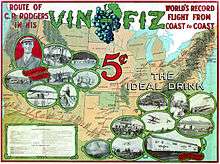
Armour Company poster showing Calbraith Perry Rodgers's Vin Fiz Flyer transcontinental flight route, autumn 1911
- First ordnance dropped from an airplane: Lieutenant Giulio Gavotti dropped grenades from his Etrich Taube airplane on Ottoman troops in Libya on November 1, 1911.[67]
- First transcontinental flight across North America: Calbraith Perry Rodgers piloted the Vin Fiz Wright Model EX pusher biplane through a seventy-plus-stop trek across the United States from Sheepshead Bay, New York to Long Beach, California from September 17 to December 10, 1911.[68]
- First parachute jump from an airplane: According to some sources, Grant Morton jumped from a Wright Model B over Venice, California, in 1911.[69][70] However credit is generally given to Albert Berry, who jumped from a Benoist biplane over Jefferson Barracks, Missouri, on March 1, 1912.[71][69]
- First night mission: Lieutenant Giulio Gavotti during the campaign against the Ottoman Empire on March 4, 1912 [72]
- First woman to fly across the English Channel: Harriet Quimby flew from Dover to Hardelot-Plage on April 16, 1912.[73]
- First airplane flight across the Irish Sea: Denys Corbett Wilson took 100 minutes to fly a Blériot XI from Goodwick in Wales to Enniscorthy in Ireland, on April 22, 1912.[74]
- First take-off by an airplane from a moving ship: Commander Charles R. Samson took off from a platform aboard the battleship HMS Hibernia in a Short Improved S.27 No. 38, on May 9, 1912.[75]
- First flight of an all-metal aircraft: The Reissner Canard, designed by Professor Hans Reissner, whose structure and skin were both all metal, was first flown on May 23, 1912 by Robert Gsell.[76][77]
- First aircraft to be captured: was that of Captain Moizo of the Italian Servizio Aeronautico, on September 10, 1912 during the Italo-Turkish War, but sources disagree on whether he was shot down, or had mechanical problems.[78][79]
- First use of a flight data recorder: Invented by George M. Dyott and used in the 1913 Dyott monoplane. It used three pointers to record movements of the control surfaces on a strip of paper run between two rollers.[80]
- First four-engine aircraft to fly: The Russian Russo-Baltic Wagon Works Большой Балтийский (Great Baltic), developed by Igor Sikorsky took to the air on May 10, 1913 after having two additional engines installed when the original pair were found to leave it underpowered.[81]
- First bombing attack against a surface ship: Didier Masson and Captain Joaquín Bauche Alcalde dropped dynamite bombs on Federalist gunboats at Guaymas, Mexico, on May 10, 1913 while flying for Mexican Revolutionist Venustiano Carranza[82]
- First propaganda leaflet flight: Didier Masson distributed propaganda leaflets from the air for the Mexican Revolutionist Venustiano Carranza, post May 10, 1913.[82]
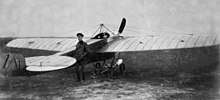
Pyotr Nesterov with the Nieuport IV.G he looped
- First loop: Pyotr Nesterov looped a Nieuport IV, on September 9, 1913.[83]
- First flight across the Mediterranean: Roland Garros flew a Morane-Saulnier G from the South of France to Tunisia, on September 23, 1913.[84]
- First aircraft to exceed 160 km/h (100 mph) in level flight Maurice Prévost flew a Deperdussin Monocoque in the 1913 Gordon Bennett Trophy race averaging over 160 km/h (100 mph) during a lap on September 28, 1913.[85]
- First dogfight: Dean Ivan Lamb flying a Curtiss pusher and Phil Rader in a Christofferson biplane traded pistol shots while airborne, during the Siege of Naco, Mexico in November or December 1913.[86]
- First scheduled commercial airplane flight:Tony Jannus flew a Benoist XIV biplane flying-boat of the St. Petersburg-Tampa Airboat Line from St. Petersburg to Tampa in 23 minutes on January 1, 1914 with a paying passenger. This service ran until May 5, 1914.[87]
- First piloted flight indoors: February 16 or 17, 1914 in San Francisco, California. Made by Lionel Heachy, the daring American airman, in the Palace of Machinery at the upcoming Panama-Pacific International Exposition of 1915). [88]
- First flight across the North Sea: On July 30, 1914, Tryggve Gran flew the 510 km (320 mi) from Cruden Bay in Scotland to Jæren in Norway in 4 hours and 10 minutes.[89]
- First aircraft downed by ground fire: On August 20, 1914 during the Battle of Cer, an Austro-Hungarian Lohner B.I of Fliegerkompagnie 13 was damaged by Royal Serbian Army small arms fire near Lešnica. The pilot escaped and the Serbs failed to repair his aircraft.
- First aircraft intentionally downed by another aircraft: Pyotr Nesterov rammed an Austrian Albatros B.II of FLIK 11 with his Morane-Saulnier G on September 7, 1914 following previous attempts using a grappling hook. Both aircraft were destroyed and all were killed.[90]
- First aircraft to shoot down another aircraft: A French Voisin III, piloted by Sergeant Joseph Frantz, and Corporal Louis Quénault as passenger, engaged a German Aviatik B.II near Rheims on October 5, 1914. After expending his machine-gun ammunition, Quénault shot the German pilot (Wilhelm Schlichting) with his rifle, causing the Aviatik to crash.[91]
- First female military pilot: Eugenie Mikhailovna Shakhovskaya was a reconnaissance pilot in the Imperial Russian Air Service, having been ordered to active service on November 19, 1914.[92]
- First aerial victory for a fighter aircraft armed with a fixed forward-firing machine gun: Roland Garros, while with Escadrille 23 of the Aéronautique Militaire worked with Raymond Saulnier on a synchronized machine gun, however when that failed, they attached steel wedges to the propeller blades, and he proceeded to down three German aircraft in March 1915 before his engine failed behind enemy lines.[93]
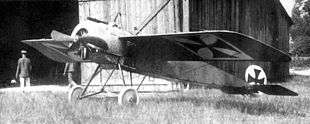
Kurt Wintgens' Fokker M.5K/MG used on July 1, 1915
- First aerial victory for a fighter aircraft armed with a forward-firing synchronized machine gun: Leutnant Kurt Wintgens of Feldflieger Abteilung 6b of the German Army's Fliegertruppe air arm, flying a Fokker M.5K/MG Eindecker, downed a French Morane-Saulnier L near Lunéville, France, on July 1, 1915.[94][95]
- First female combat fighter pilot: Marie Marvingt flew combat missions for France in 1915.[96][97]
- First sinking of a ship with an aerial torpedo: Charles Edmonds in a Short 184 torpedoed and sank an abandoned Turkish supply ship in the Sea of Marmara on August 12, 1915.[98][99]
- First downing of a military aircraft with artillery fire: Serbian Army private Radoje Ljutovac hit an Austro-Hungarian aircraft on September 30, 1915 during a bombing raid on Kragujevac.[100][101]
- First combat search and rescue by airplane: Richard Bell Davies landed his Nieuport 10 to rescue another pilot who had been shot down in Bulgaria on November 19, 1915.[102]
- First medical evacuation (medevac) by air: Louis Paulhan evacuated the seriously ill Milan Stefanik from the Serbian front in 1915.[103]

Felixstowe Porte Baby with Bristol Scout composite before flight
- First black military pilot: Ahmet Ali Çelikten a.k.a. Arap Ahmet Ali was the first black military pilot, served in Ottoman Aviation Squadrons from 1914 or 1915.[104][105][106][82][107]
- First flight of a parasite or composite airplane: A Felixstowe Porte Baby carried aloft and then launched a Bristol Scout while in flight on May 17, 1916.[108]
- First air-to-air rocket attack to down an aircraft: Eight aces including Nungesser downed six observation balloons on May 22, 1916 while flying Nieuport 16s armed with Le Prieur rockets, blinding the German Army for a French counter-attack on Fort Douaumont.[109]
- First air-to-ground rocket attack: A roving Nieuport 16 equipped with Le Prieur rockets found a large ammunition dump, on June 29, 1916 and blew it up.[110]
- First submarine sunk by aircraft: HMS B10 was sunk by Lohner L aircraft of the Kaiserliche und Königliche Seeflugwesen (Austrian Naval Air Service) while tied up at Venice on August 9, 1916.[111]
- First submarine sunk while underway by aircraft: French submarine Foucault was bombed by two Austro-Hungarian Lohner L seaplanes while off Cattaro on September 15, 1916, which resulted in Foucault being forced to surface and her crew to abandon ship.[112]
Practical flight 1917-1938
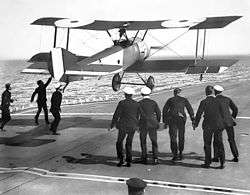
- First landing by an airplane on a moving ship: Squadron Commander Edwin Dunning landed a Sopwith Pup on HMS Furious on August 2, 1917.[113]
- First flight by an all-metal aircraft with a stressed skin monocoque primary structure: by the Zeppelin-Lindau (Dornier) D.I cantilever biplane on June 4, 1918. It would also be the first such aircraft to enter production.[114][115]
- First flight by an airplane across the Andes: Luis Candelaria flew from Zapala, Argentina, to Cunco, Chile, in a Morane-Saulnier Type L parasol monoplane on April 13, 1918, reaching an altitude of 4,000 m (13,000 ft).[116]
- First attack by aircraft launched from an aircraft carrier: Sopwith Camels flown from HMS Furious for the Tondern raid on July 19, 1918 destroyed Zeppelins L 54 and L 60.[117]
- First flight across the Andes above highest peaks: Teniente Dagoberto Godoy crossed from Chile to Argentina in a Bristol M.1C, on December 12, 1918, reaching an altitude of 6,300 m (20,700 ft), without oxygen.
- First transatlantic flight: Albert Cushing Read with a crew of five in a US Navy Curtiss NC flying boat, the NC-4, flew from New York City to Plymouth, England via the Azores and Portugal from May 8–31, 1919, stopping 23 times.[118]
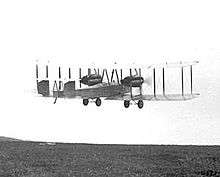
Alcock and Brown beginning their non-stop transatlantic flight in their Vickers Vimy
- First non–stop transatlantic flight: John Alcock and Arthur Brown flew a Vickers Vimy from St. John's, Newfoundland, to Clifden, Ireland, on June 14–15, 1919.[119]
- First stowaways (human and animals) on a transatlantic air journey: July 2-6, 1919, on the R34 airship William Ballantyne and his small tabby cat, Wopsie, smuggled themselves onboard the airship R34 as the first transatlantic stowaways in the flight from the UK to Mineola, Long Island. There were also two homing pigeons. Thus, these were the three animals to fly across the Atlantic. Ballantyne returned to the UK by ship. [120] [121]
- First England to Australia flight: brothers Keith and Ross Macpherson Smith, with mechanics Sergeant Wallace H. Shiers and James M. Bennett, flew from Hounslow Heath Aerodrome to Darwin in a Vickers Vimy on December 10, 1919, winning a prize of £A10,000.[122]
- First Rome to Tokyo flight: Arturo Ferrarin (and engineer Gino Cappannini) in an Ansaldo SVA biplane in winning the Rome–Tokyo Raid on May 31, 1920
- First African–American or Native American or black person to obtain an international pilot's license: Bessie Coleman on June 15, 1921 on a Nieuport 82.[123][124]
- First capital ship sunk by aircraft: Under orders from Brigadier General William L. Mitchell, one Handley-Page O/400 and six Martin NBS-1 bombers led by Capt. Walter R. Lawson bombed the captured ex-German World War I battleship, Ostfriesland during a series of airpower tests, sinking it on July 21, 1921.[125]
- First flight to sustain a speed over 320 km/h (200 mph) : Joseph Sadi-Lecointe flew a Nieuport-Delage Sesquiplan racer over a distance of 100 km (62 mi) at an average speed in excess of 320 km/h (200 mph) on September 30, 1922.[126]
- First aerial crossing of the South Atlantic (with aircraft replacement): Artur de Sacadura Cabral and Gago Coutinho flew from Lisbon, Portugal, to Rio de Janeiro, Brazil, in a total of three Fairey III floatplanes between March 30 and June 17, 1922.[127] The first to use astronomical navigation (and to rely solely on it during the crossing), with an artificial horizon for aeronautical use.[128][129]
- First autogyro/autogiro flight: Alejandro Gomez Spencer made the first successful Autogyro flight in the Cierva C.4 on January 9, 1923 (O.C.), previous designs having failed to achieve flight.[130]
- First aerial refueling: A De Havilland Airco DH.4B biplane of the United States Army Air Service successfully refuelled another DH.4B, piloted by Lowell Smith, in mid-air on June 27, 1923.[131]
- First flight from Portugal to China: Using two different aircraft, Sarmento de Beires and Brito Pais flew 16,380 km (10,180 mi) in 115 hours 45 minutes of flying time[132][133] from Vila Nova de Milfontes, Alentejo to Shenzhen, near Hong Kong, between April 7 and June 20, 1924,[134][135]

USAAS Douglas World Cruisers on their world circumnavigation flight
- First aerial circumnavigation: Pilots Lowell H. Smith, Erik H. Nelson and John Harding Jr., in a pair of Douglas World Cruisers of the United States Army Air Service completed an aerial east–west circumnavigation of the world starting and ending in Seattle Washington, between April 6 and September 28, 1924.[136]
- First Amsterdam to Tokyo flight: Pedro Leandro Zanni and mechanic Felipe Beltrame, flew 17,015 km (10,573 mi), with a change of aircraft in Hanoi, from July 26 to October 11, 1924, with a flight time of 119 hours 50 minutes.[137][138]
- First aerial crossing of the South Atlantic (single aircraft): Ramón Franco, Julio Ruiz de Alda Miqueleiz, Juan Manuel Duran and Pablo Rada, made between Spain and South America in the Plus Ultra, in January 1926.
- First solo non-stop New York to Paris transatlantic flight: Charles Lindbergh, flying the Spirit of St. Louis, made the 33-hour journey from New York to Paris on May 20–21, 1927, winning the Orteig Prize.[139]
- First flight from U.S. mainland to Hawaii: U.S. Army lieutenants Albert Francis Hegenberger and Lester J. Maitland flew from California to Hawaii in the Bird of Paradise, a C-2 transport, on June 28–29, 1927.[140]
- First female airline pilot: Marga von Etzdorf was hired by Lufthansa in 1927.[141] One year later, Mary, Lady Heath, was hired by KLM.
- First east–west non–stop transatlantic crossing: the Bremen, a Junkers W 33 flown by Hermann Köhl with James Fitzmaurice as copilot, flew from Baldonnel, Ireland to Greenly Island in Quebec from April 12–13, 1928[142]
- First long distance mass formation flight: Italo Balbo led 60 Savoia-Marchetti S.55 flying boats from May 25 to June 2, 1928 from Tuscany over the Balearic Islands, along Spanish and French coasts, and finally returning to Italy.[143]
- First transpacific flight (US to Australia): Charles Kingsford Smith and crew, in the Southern Cross, flew from Oakland, California, to Brisbane, Australia, between May 31 and June 9, 1928.[144]
- First woman to fly across the Atlantic (as passenger): Amelia Earhart was flown by Wilmer Stultz and Louis Gordon, in a Fokker F.VII, from Trepassey, Newfoundland, to Burry Port, Wales, on June 17, 1928.[145]
- First sea-launched flight to deliver transatlantic (westbound, Europe-to-USA) mail: Baron Jobst von Studnitz, flying a Heinkel HE 12 floatplane and carrying 11,000 pieces of mail from Europe, was launched from the deck of the new ND-Lloyd liner, the SS Bremen on its maiden voyage, some twenty miles off Fire Island, New York, to deliver the mail to New York City several hours before the ship docked at 58th Street, Brooklyn docks. July 26, 1929.[146]
- First flight over the South Pole: in the "Floyd Bennett", a Ford 4-AT-B trimotor flown by Bernt Balchen with Harold June as co-pilot and Richard E. Byrd navigating, arriving shortly after midnight on November 29, 1929.[147][148]
- First trans-oceanic mass formation flight: Italo Balbo led twelve Savoia-Marchetti S.55 flying boats from Orbetello Airfield, Italy to Rio de Janeiro, Brazil between December 17, 1930 and January 15, 1931 which was documented in the first Italian aviation film Atlantic Flight (1931 film).[143]
- First solo trans–Tasman flight: Guy Menzies, flying an Avro Avian named the Southern Cross Junior, took off from Sydney on January 7, 1931, and crash-landed in a swamp near Hari Hari, New Zealand, nearly twelve hours later.[149]
- First nonstop flight across the Pacific: Clyde Pangborn and Hugh Herndon flew 41 hours, 13 minutes in Miss Veedol from Samushiro, Japan, to Wenatchee, Washington, on October 4–5, 1931.[150]
- First female pilot to fly solo across the Atlantic Ocean: Amelia Earhart, in a Lockheed Vega 5B, flew from Harbour Grace, Newfoundland, to Culmore, Ireland, on May 20, 1932.[151]
- First successful helicopter with a single main lifting rotor: Alexei Cheremukhin and Boris Yuriev's TsAGI-1EA, which flew to a record altitude of 605 m (1,985 ft) on August 14, 1932.[152][153]
- First flight over Mount Everest: Lord Clydesdale in a Westland PV-3 and David McIntyre, in a Westland PV-6 flew over Everest on April 3, 1933 during their Houston–Mount Everest flight expedition.[154]
- First scheduled commercial trans-Pacific passenger service: A Pan-American Martin M-130 began a proving flight on November 22, 1935 that led to passengers being carried on a regularly scheduled service from San Francisco to Manila that began on October 21, 1936.[155]
- First trans–polar flight: A Tupolev ANT-25RD flown by Valery Pavlovich Chkalov with copilot Georgi Filippovich Baidukov and navigator Alexander Vasilyevich Belyakov from Schelkovo air base on the outskirts of Moscow, to Pearson Field in Vancouver, Washington, crossing the Arctic for the first time from June 18–20, 1937 over a distance of 9,130 km (5,670 mi) in 63 hours and 25 minutes.[156]
- First transatlantic commercial proving flights and quadruple crossing: An Imperial Airways Short Empire flying boat and a Pan-American Sikorsky S-42 flying boat both crossed the Atlantic on July 5, 1937, and then made the return flight. Both aircraft were operating at the extreme limits of their respective ranges, and so commercial service didn't start until a few years later.[157]
- First flight of a commercial aircraft with a pressurized cabin: was made on December 31, 1938 by the Boeing 307 Stratoliner.[158]
Jet age, 1939–present
- First flight by a liquid-fueled rocket-powered aircraft: The Heinkel He 176, piloted by Erich Warsitz, made its first flight on June 20, 1939.[159]
- First scheduled commercial transatlantic passenger service: Pan American Boeing 314 Clipper Yankee Clipper flying boats made the first scheduled commcercial flight between New York City and Marseille, France on June 28, 1939.[160]
- First flight by a turbojet-powered aircraft: The Heinkel He 178, piloted by Erich Warsitz, made its maiden flight on August 27, 1939.[161]
- First flight of an aircraft powered by a motorjet/thermojet: Caproni Campini N.1 on August 27, 1940[162]
- First capital ships sunk by aircraft while underway: HMS Repulse was sunk on December 10, 1941 by Japanese Mitsubishi G4M twin-engine torpedo bombers of the Kanoya, Genzan and Mihoro Air Groups, the first capital ship to be sunk while underway. The accompanying HMS Prince of Wales was sunk shortly afterwards.[163]
- First purpose-built jet bomber to fly: The first prototype of a new jet reconnaissance-bomber, the Arado Ar 234 made its first flight on July 30, 1943.[164]
- First combat sortie by a rocket-powered aircraft: Major Späte of the EK 16 service test unit flew a Messerschmitt Me 163B Komet interceptor against Allied aircraft on May 13, 1944.[165]
- First aerial combat with a jet fighter: A Messerschmitt Me 262 jet fighter flown by Leutnant Alfred Schreiber of Ekdo 262 service test unit attacked an RAF 540 Squadron de Havilland Mosquito on July 26, 1944, but failed to shoot it down.[166]
- First turboprop powered aircraft to fly: A modified Gloster Meteor F.I powered by two Rolls-Royce Trent turbine engines driving propellers, became the first turboprop powered aircraft to fly on September 20, 1945.[167]
- First scheduled commercial transatlantic passenger service using landplanes: American Overseas Airlines Douglas DC-4 landplanes provided the first scheduled passenger flight between New York City and Hurn Airport near Bournemouth in England via Gander, Newfoundland, and Shannon, Ireland on October 23, 1945.[168]
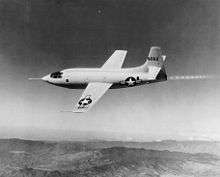
- First documented supersonic flight: Chuck Yeager exceeded the speed of sound in a Bell X-1 on October 14, 1947.[169]
- First flight by a jet transport: A Rolls-Royce Nene-powered Vickers VC.1 Viking became the first jet-powered airliner to fly on April 6, 1948.[170]
- First nonstop around-the-world flight: B-50A Superfortress Lucky Lady II, commanded by Capt. James Gallagher, flew around the world from February 26 to March 2, 1949, taking off and landing at Carswell AFB, Texas. The Superfortress refuelled inflight four times from KB-29M tankers.[171]
- First aircraft to exceed Mach 2: Scott Crossfield was first to fly at twice the speed of sound in a Douglas D-558-II Skyrocket on November 20, 1953.[172]
- First human trials / flights using a Jetpack / Flying Rocket Belt: late 1960 - February 1961, Engineer Wendell Moore. Early research and development for this device was between Bell Laboratories and US Military. Engineer Moore was helped by gas turbine specialist John Hulbert in the early development stages; then Moore actually flew the first flights himself including 1st acknowledged test on February 1961. [173]
- First pole-to-pole circumnavigation: was completed by Captains Fred Austin, and Harrison Finch on 15 November 1965 with a Boeing 707-349C named "Pole Cat" leased from the Flying Tiger Line, in 57 hours, 27 minutes.[174]
- First woman to fly for a major U.S. airline: In March 1973 Bonnie Tiburzi became the first female pilot for a major U.S. airline, American Airlines.
- First supersonic scheduled passenger flights: Concorde, the first supersonic airliner flew from London to Bahrain, and from Paris to Rio de Janeiro on January 21, 1976.[175]
- First solo trans-Atlantic flight by helicopter: Dick Smith flew a Bell Jetranger III solo across the Atlantic in August 1982.[176]
- First circumnavigation by helicopter: H. Ross Perot, Jr. and Jay Coburn in a Bell 206L-1 LongRanger II ("Spirit of Texas"), September 1-30, 1982.[177]
- First solo circumnavigation by helicopter: Dick Smith, Bell Jetranger III, 1982–83.[178]
- First non-stop, un-refueled flight around the Earth: Dick Rutan and Jeana Yeager in the Rutan Model 76 Voyager took 9 days, 3 minutes and 44 seconds to circumnavigate the globe from December 14 to 23, 1986.[175]
- First all-female jet airliner cockpit and flight attendant crew: Beverley Bass captained the American Airlines flight of a Boeing 727 from Washington D.C. to Dallas, Texas on December 30, 1986.[179]
- First helicopter to the North Pole: Dick Smith on April 28, 1987 in Bell Jetranger III VH-DIK.[180]
- First circumnavigation landing at both poles: Dick Smith, 1988–1989, Twin Otter.[181][182]
- First east-west circumnavigation by helicopter: Dick Smith, 1994–1995, Sikorsky S-76.[183]
- First deployment of a certified whole-plane parachute recovery system: Scott D. Anderson successfully flew all 7 inflight test deployments of the Cirrus Airframe Parachute System (CAPS). The tests were done in a Cirrus SR20 during the summer of 1998; the plane became type certified in October of that year.[184][185][186]
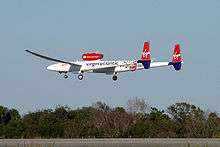
The GlobalFlyer that Steve Fossett piloted around the world
- First to land helicopter at both Poles: Quentin Smith & Steve Brooks, October 2002 (North), January 2005 (South), Robinson R44[187]
- First solo non-stop fixed-wing aircraft flight around the Earth: Steve Fossett flew from Salina, Kansas, eastbound and back, on a Virgin Atlantic GlobalFlyer, from February 28-March 3, 2005, taking a total time of 67 hours.[188]
- First solo flight(s) by armless pilot (no prosthetics): May 10, 2008, civilian Jessica Cox. Cox, born 1983 without arms, earned her pilot's license in 2008. Just using her legs, Cox made first local flight in San Manuel airport (E77), Arizona. On October 10, 2008, she made a point-to-point flight San Manuel to San Carlos (P13) and back (both AZ airports). [189]
- First piloted overnight solar-powered flight in a fixed-wing aircraft: Andre Borschberg piloted the Solar Impulse 1 for a continuous flight of more than 24 hours, between July 7–8, 2010.[190]
- First trans-Atlantic flight by autogyro: Norman Surplus flew solo across the Atlantic from Belfast, Maine, to Larne, Northern Ireland in Rotorsport UK MT-03 Autogyro "Roxy" between July 8, 2015 and August 11, 2015.[191][192]
- First piloted non-stop solar-powered transatlantic flight: Bertrand Piccard flew from New York City to Seville in the Solar Impulse 2 between June 20–23, 2016.[193]
- First circumnavigation of the world by a piloted fixed-wing aircraft using only solar power: Solar Impulse 2 between March 2015 and July 2016; Borschberg and Piccard alternated piloting stages of the journey.[194]
- First circumnavigation by autogyro: Norman Surplus flew a RotorSport UK MT-03 between June 1, 2015 and June 28, 2019 from McMinnville, Oregon, USA, for an eastbound circumnavigation.[191][192]
- First female US Air Force pilot to fly Stealth F-35A in combat: 9 June 2020, Capt. Emily Thompson Capt. Emily Thompson of the E421st Expeditionary Fighter Squadron flew a Stealth F-35A in a combat mission. Another first was Thompson's plane was serviced by an all female crew. USAF did not disclose other flight details. [195]
- First type certificate for an electric aeroplane: The Pipistrel Velis Electro becomes the first electric aircraft in the World to receive a type certificate by EASA, on June 10, 2020.[196]
See also
- Australian aviation firsts
- Circumnavigation
- List of circumnavigations
- Firsts in human spaceflight
- Timeline of women in aviation
References
Notes
- Zizhi Tongjian 167. "(永定三年)使元黄头与诸囚自金凤台各乘纸鸱以飞,黄头独能至紫陌乃堕,仍付御史中丞毕义云饿杀之。" (Rendering: In the 3rd year of Yongding, 559, Gao Yang conducted an experiment by having Yuan Huangtou and a few prisoners launch themselves from a tower in Ye, capital of the Northern Qi. Yuan Huangtou was the only one who survived from this flight, as he glided over the city-wall and fell at Zimo [western segment of Ye] safely, but he was later executed.)
Citations
- William of Malmesbury – ed. and trans. R. A. B. Mynors, R. M. Thomson, and M. Winterbottom (1998-9). Gesta regum Anglorum / The history of the English kings. Oxford Medieval Texts.
- "Who is Hezarfen Ahmet Çelebi?". Archived from the original on January 21, 2016. Retrieved January 21, 2016.
- "The First Man to Fly". Archived from the original on January 21, 2016. Retrieved January 21, 2016.
- Winter, Frank H. (1992). "Who First Flew in a Rocket?", Journal of the British Interplanetary Society 45 (July 1992), p. 275-80
- Harding, John (2006), Flying's strangest moments: extraordinary but true stories from over one thousand years of aviation history, Robson Publishing, p. 5, ISBN 978-1861059345
- Ryan, Craig (2003). The Pre-Astronauts: Manned Ballooning on the Threshold of Space. Naval Institute Press. p. 37. ISBN 978-1591147480.
- Brady, Tim (2000). The American Aviation Experience: A History. SIU Press. p. 310. ISBN 978-0809323715.
- Oborne, Michael W. (1998). A History of the Château de la Muette. OECD Publishing. pp. 86–7. ISBN 978-9264161610.
- "CIA Balloon and Airship Hall of Fame 2000 Inductees". The International Air Sports Federation. September 2000. Archived from the original on July 2, 2004.
- Hallion, Richard P. (2003). Taking Flight: Inventing the Aerial Age, from Antiquity through the First World War. Oxford University Press. p. 58. ISBN 978-0195160352.
- "Boston's first aeronaut". The New York Times. July 10, 1885.
- Byrne, Michael (January 9, 2007). "The Tullamore Balloon Fire - First Air Disaster in History". Offaly Historical and Archaeological Society website. Archived from the original on March 26, 2012. Retrieved January 18, 2013.
- Fulgence, Marion. "Part 2, Chapter 10: The Necrology of Aeronautics". Wonderful Balloon Ascents. Cassel Petter & Galpin.
- Davy 1937, p.46
- "Sophie Blanchard – First Woman Balloon Pilot". Historic Wings. July 6, 2012. Archived from the original on January 21, 2013.
- "The Giffard Airship, 1852". The Science Museum, London. Archived from the original on May 26, 2013. Retrieved January 21, 2013.
- Loving, Matthew (2011). Bullets and Balloons: French Airmail during the Siege of Paris. Franconian Press.
- Williams, Amanda (December 12, 2012). "Victorian Paris photographed from the air". The Daily Mail. Archived from the original on January 21, 2013.
- "Was Brazilian first to fly?". The Leader-Post. November 12, 1986.
- Motoring Illustrated, August 2, 1902, pp 215-216
- "A Lady navigates an airship". Manawatu Times. September 11, 1902. p. 3.
- "The Airship Heritage Trust - R34 - The Record Breaker - Atlantic Crossing". airshipsonline.com. The Airship Heritage Trust. Retrieved June 21, 2017.
- The Transatlantic Voyage of R.34 Flight 10 July 1919, pp. 906–10
- Ryan, Craig (2003). The Pre-Astronauts: Manned Ballooning on the Threshold of Space. Naval Institute Press. pp. 40–44. ISBN 978-1591147480.
- Harden, Blaine (May 13, 1980). "Balloonists Cross the Continent". The Washington Post. Retrieved May 24, 2019.
- Cawsey, Richard. "Roziere Balloons". Bison Consultants Ltd. Retrieved April 30, 2016.
- "Crossing of Australia by hot air balloon". Australian Geographic. June 18, 2014. Retrieved March 9, 2015.
- "Trans-Pacific trek beats ballooning flight record". Lawrence Journal-World. February 19, 1995.
- Johnson, Glen (September 24, 1999). "Historic balloon on show". The Free Lance-Star.
- "Speaker Dick Smith Full Biography". Inform Communicate Motivate International (Australia). Archived from the original on September 2, 2007. Retrieved September 19, 2007.
- Tinkler, Emma (July 7, 2002). "Fossett lands after first around-the-world solo balloon quest". The Daily Courier. Yavapai County, Arizona.
- Wragg, David; Flight before Flying, Osprey, 1974.
- Fairlie, Gerard and Cayley, Elizabeth; The Life of a Genius, Hodder & Stoughton, 1965.
- Anderson, John D. (1999). A History of Aerodynamics: And Its Impact on Flying Machines. Cambridge University Press. p. 155. ISBN 978-0521669559.
- Gray, Carrol F. (August 2002). "The First Five Flights". WW1 Aero - the Journal of the Early Aeroplane (117): 26–39.
- Howard, Fred (1988). Wilbur and Orville: A Biography of the Wright Brothers. Courier Dover Publications. p. 161. ISBN 978-0486402970.
- Gunston, 1992, p.62
- "The Prize Patrol". Wright Brothers Aeroplane Company. Retrieved January 21, 2013.
- "A Century of Sporting Achievements". Fédération Aéronautique Internationale. November 15, 2006. Archived from the original on January 21, 2013.
- Vivian, E. Charles (2004). A History of Aeronautics. [S.l.]: Kessinger Pub. pp. 134–135. ISBN 978-1419101564.
- Crouch, Tom (1982). Blériot XI: The Story of a Classic Aircraft. Smithsonian Institution Press. p. 22.
- AFP (July 25, 2009). "English Channel Armada to Mark Centenary of Louis Blériot Flight". Times of Malta. Retrieved September 14, 2015.
- "Fatal Fall Of Wright Airship". New York Times. September 18, 1908. Retrieved October 17, 2010.
- Gunston, 1992, p.58
- Gunston, 1992, p.66
- Pattison, Jo (October 1, 2009). "First to fly across the Channel". BBC News – Kent. Retrieved January 21, 2013.
- "Blériot Tells of his Flight" (PDF). The New York Times. July 26, 1909. Retrieved January 21, 2013.
- "The New 'Daily Mail' Prizes". Flight. 5 (223): 393. April 5, 1913.
- Arnold-Baker, Charles (1996). The Companion to British History. London: Routledge. ISBN 0-415185831.
- "Aviation notes of the week - Mr. Moore-Brabazon Flies Across Country". Flight. November 13, 1909. Retrieved August 11, 2019.
- Gunston, 1992, p.80
- Air Trails, July 1953. "The Brave Baroness – First Licensed Ladybird" by Harry Harper.
- "First 10 women in the world to earn a pilot license". Institute for Women Of Aviation Worldwide. Retrieved December 5, 2015.
- Thurston, David E. (2000). The World's Most Significant and Magnificent Aircraft: Evolution of the Modern Airplane. SAE. p. 67. ISBN 978-0768005370.
- Gunston, 1992, p.78
- "King up in aeroplane" (PDF). The New York Times. July 16, 1910.
- Gunston, 1992, p.81
- Haddon, Gerald (March 29, 2019). "J.A.D. McCurdy: the father of Canadian military aviation". Retrieved November 5, 2019.
- Gunston, 1992, p.82
- "Aeroplanes in Collision". New York Times. October 2, 1910. p.11.
- Driver, Hugh (1997). The Birth of Military Aviation: Britain, 1903-1914. Boydell & Brewer Ltd. p. 110. ISBN 978-0861932344.
- "Eugene Ely's Flight from USS Birmingham, 14 November 1910". Naval History & Heritage Command. Retrieved January 21, 2013.
- "Eugene Ely's Flight to USS Pennsylvania, 18 January 1911". Naval History & Heritage Command. Retrieved January 21, 2013.
- "London To Paris By Aeroplane." Times [London, England] 13 April 1911: 8. The Times Digital Archive. Web. 8 Nov. 2013.
- "Month of achievement in aviation". Popular Mechanics: 350. August 1911.
- "Flies over the Rockies" (PDF). The New York Times. October 1, 1911.
- Hippler, Thomas (2013). Bombing the People. pp. 1–2. ISBN 978-1107037946. Retrieved August 17, 2017.
- Strother, French (January 1912). "Flying Across The Continent: C. P. Rodgers And The First Aerial Trans-Continental Trip". The World's Work: A History of Our Time. XXIII: 339–345. Retrieved July 10, 2009.
- Bates, Jim (1990). Parachuting: From Student to Skydiver. Tab Books. p. 42. ISBN 978-0830634064.
- Poynter, Dan (1984). The Parachute Manual: A Technical Treatise on Aerodynamic Decelerators. Para Publishing. p. 160. ISBN 978-0915516353.
- Wright, Robert K.; Greenwood, John T. (2007). Airborne Forces at War: From Parachute Test Platoon to the 21st Century. Naval Institute Press. p. 1. ISBN 978-1591140283.
- "Libya 1911: How an Italian pilot began the air war era". BBC News Website. May 10, 2011. Retrieved May 10, 2011.
- "Miss Quimby flies English Channel" (PDF). The New York Times. April 17, 1912.
- "This day in Irish History 1912: The 1st Flight across the Irish Sea". Politics.ie. April 22, 2012.
- "The Naval Review and the Aviators". Flight. IV (20): 442. May 18, 1912.
- Ballhaus, W.F., Jr.; Hussaini, M.Y. (2012). Advances in Fluid Dynamics. Springer Science & Business Media. pp. 108–109. ISBN 978-1461236849.
- Zoeller, Horst (September 19, 2019). "Reissner Ente". hugojunkers.bplaced.net. Retrieved November 1, 2019.
- Robertson, Patrick (2011). Robertson's Book of Firsts: Who Did What for the First Time. Bloomsbury USA. ISBN 978-1596915794.
- Crabtree, James D. On air defense. Greenwood Publishing. p. 9. ISBN 0275947920.
- Van Hare, Thomas (April 28, 2013). "Dyott's Flight Data Recorder". fly.historicwings.com. Retrieved November 1, 2019.
- Gunston, 1992, p.109
- Hagedorn, Dan (2008). Conquistadors of the Sky: A History of Aviation in Latin America. Smithsonian National Air and Space Museum. p. 76. ISBN 978-0813032498.
- Diamond, Karen (April 2000). "Classic memories from the world of aerobatics". Air Sports International. Archived from the original on April 24, 2001.
- "Roland Garros Flies Over Mediterranean Sea". Dalje. September 23, 2008. Archived from the original on October 20, 2012. Retrieved January 21, 2013.
- "The Gordon Bennett Race". Flight International. October 4, 1913.
- "This Week in USAF and PACAF History – 24-30 November 2008" (PDF). Pacific Air Forces. Archived from the original (PDF) on January 21, 2013.
- Glines, C. V. (May 1997). "St. Petersburg-Tampa Airboat Line: World's First Scheduled Airline Using Winged Aircraft". Aviation History.
- (New York) Evening Post. LXXXVII (41): 4. February 18, 1914. Missing or empty
|title=(help) - "Lieut. Gran's Flight To Norway". Flight. VI (293): 837. August 7, 1914.
- Jon Guttman, et al. Pusher Aces of World War 1. London: Osprey Pub Co, 2009. ISBN 978-1846034176 p.9
- Guttman, John (2009). Pusher Aces of World War I. Osprey Publishing. p. 9. ISBN 978-1846034176.
- Robson, Pamela (2011). Wild Women: History's Female Rebels, Radicals and Revolutionaries. Pier 9. ISBN 978-1741966329.
- Bruce, J.M. (1989). Morane Saulnier Type L. Windsock Datafile 16. Herts, UK: Albatros Publications. p. 3. ISBN 0-948414-20-0.
- vanWyngarden, Greg (2006). Osprey Aircraft of the Aces #73: Early German Aces of World War 1. Botley, Oxford UK & New York City, USA: Osprey Publishing. pp. 11 & 12. ISBN 978-1841769974.
- Sands, Jeffrey, "The Forgotten Ace, Ltn. Kurt Wintgens and his War Letters", Cross & Cockade USA, Summer 1985.
- "1915 - First woman pilot in combat missions as a bomber pilot - Marie Marvingt (France)". Centennial of Women Pilots. Archived from the original on January 11, 2015. Retrieved January 10, 2015.
- Historic Wings – Online Magazine; Article on Hélène Dutrieu Coupe Femina and Marie Marvingt:, Published on December 21, 2012: http://fly.historicwings.com/2012/12/helene-dutrieux-and-the-coupe-femina Retrieved 10 January 2015.
- Nicolaou, Stéphane (1998). Flying Boats & Seaplanes: A History from 1905. Bay View Books Ltd. p. 54. ISBN 978-1901432206.
- Guinness Book of Air Facts and Feats (3rd ed.). 1977.
- "How was the first military airplane shot down". National Geographic. Retrieved August 5, 2015.
- "Radoje Raka Ljutovac – first person in the world to shoot down an airplane with a cannon". Pečat. Retrieved August 5, 2015.
- Galdorisi, George; Phillips, Thomas (2009). Leave No Man Behind: The Saga of Combat Search and Rescue. Zenith Imprint. pp. 5–6. ISBN 978-0760323922.
- L'homme-vent, special issue of L'Ami de Pézenas, 2010, ISSN 1240-0084.
- "Türk Deniz Havacılık Tarihi" (in Turkish). Archived from the original on August 5, 2010. Retrieved August 16, 2014.
- Kurter, Ajun (2009). Türk Hava Kuvvetleri Tarihi (History of Turkish Air Force , Volume 5) (in Turkish). 5. Air Force Command. p. 299.
- Dünyanın ilk siyahi pilotu: ARAP AHMET -4 "Pilotlarla Dolu Bir Aile", Posta, March 20, 2011. (in Turkish)
- [http://www.habervitrini.com/dunyanin_ilk_siyah_pilotu_arap_ahmet-518917.html DÜNYANIN İLK SİYAH PİLOTU: ARAP AHMET Archived 2011-03-11 at the Wayback Machine, Havervitrin, March 8, 2011. (in Turkish)
- Bruce, J.M. (December 2, 1955). "The Felixstowe Flying-Boats: Historic Military Aircraft No. 11 Part 1". Flight. p. 845.
- Guttman, Jon (2005). Balloon-busting aces of World War 1. Osprey aircraft of the aces 66. Oxford, UK: Osprey. p. 12. ISBN 978-1841768779.
- Albin, Denis. "Escadrille MF 62 - N 62 - SPA 62". Retrieved June 12, 2019.
- Kemp, Paul J. (1990). British Submarines of World War One. London: Arms and Armour Press. p. 8. ISBN 978-1854090102.
- Price, A (1973). Aircraft versus Submarine. pp. 13–14. ISBN 1844150917.
- Bishop, Chris; Chant, Chris (2004). Aircraft Carriers: The World's Greatest Naval Vessels and Their Aircraft. Zenith Imprint. p. 106. ISBN 978-0760320051.
- Grosz, Peter (1998). Dornier D.I Windsock Mini datafile # 12. Hertfordshire, UK: Albatros Publications. ISBN 978-0948414923.
- Gray, Peter; Thetford, Owen (1970). German Aircraft of the First World War (second ed.). London: Putnam. p. 580.
- Luis Casabal (April 13, 1998). "A 80 años del primer cruce aéreo de los Andes" (in Spanish). Diario La Nación. Retrieved April 26, 2015.
- Layman, R. L. (1973). "Furious and the Tondern Raid". Warship International. Vol. X no. 4. pp. 374–385.
- "First Across".
- "Alcock and Brown". The Aviation History Online Museum. Retrieved January 21, 2013.
- Baker, Hannah (July 2, 2018). "Bristol children invited to invent aircraft for cat". bristolpost.
- "Did others fly across the Atlantic before Lindbergh?". The Straight Dope. March 25, 2003.
- McCarthy, John. "Smith, Sir Ross Macpherson (1892–1922)". Sir Ross Macpherson Smith. Australian Dictionary of Biography. National Centre of Biography, Australian National University. Retrieved January 21, 2013.
- "U.S. Centennial of Flight Commission". United States Government. Archived from the original on January 2, 2012.
- Bix, Amy Sue (2005). "Bessie Coleman: Race and Gender Realities Behind Aviation Dreams". In Dawson, Virginia Parker; Bowles, Mark D. (eds.). Realizing the Dream of Flight: Biographical Essays in Honor of the Centennial of Flight, 1903-2003. NASA. pp. ix, 5. OCLC 60826554.
- "Winged Defense," William Mitchell, Originally published by G.P. Putnam's Sons, New York and London, 1925. (ISBN 0-486-45318-9) Reissued by Dover Publications, Inc., New York, 2006.
- "The Race for the Coupe Deutsch Trophy". Flight. Vol. XIV no. 40. October 5, 1922. p. 573.
- Dierikx, Marc (2008). Clipping the Clouds: How Air Travel Changed the World. ABC-CLIO. p. 7. ISBN 978-0313059452.
- Neves, F. M. S. P.; Barata, J. M. M.; Silva, A. R. R. (2010). "Gago Coutinho and the Aircraft Navigation" (PDF). American Institute of Aeronautics and Astronautics. Archived from the original (PDF) on December 8, 2015. Retrieved December 5, 2015.
- Bud, Robert; Warner, Deborah Jean (1998). Instruments of Science: An Historical Encyclopedia. Taylor & Francis. p. 533. ISBN 978-0815315612.
- Charnov, Bruce H (March 3, 2016). "Cierva, Pitcairn and the Legacy of Rotary-Wing Flight" (PDF). Hofstra University. Archived from the original (PDF) on March 3, 2016. Retrieved November 22, 2011.
- "First air-to-air refuelling". National Museum of the US Air Force. Retrieved October 16, 2016.
- Força Aérea Portuguesa: De Lisboa a Macau
- Swopes, Brian R. "7 April 1924". Retrieved May 10, 2019.
- d’Assumpção, H A (April 17, 2018). "From Portugal to Macau". Retrieved May 10, 2019.
- Taylor, John W R; Munson, Kenneth (1972). History of Aviation. Crown Publishers. ISBN 978-0706402414.
- Glines, Charles (2001). Around the world in 175 days. Smithsonian Institution Press. ISBN 978-1560989677.
- "Visitors: the Argentine Connection". January 3, 2013. Retrieved May 9, 2019.
- "World Flier Zannii arrives in Hong Kong-22 Sept. 1924". Gwulo: old Hong Kong. Retrieved May 9, 2019.
- "Lindbergh Flies the Atlantic, 1927". Charles Lindbergh – An American Aviator. Retrieved January 21, 2013.
- Maurer, Maurer (1987). Aviation in the U.S. Army, 1919-1939. Maxwell AFB: United States Air Force Historical Research Center. pp. 256–260.
- "Marga von Etzdorf – Germany". Institute for Women of Aviation Worldwide. July 25, 2015. Retrieved December 5, 2015.
- Hotson, Fred W. (1988). The Bremen. Toronto, ON: CANAV Books. ISBN 978-0921022022.
- Esposito, Fernando (2015). Fascism, Aviation and Mythical Modernity. Springer. p. 326. ISBN 978-1137362995.
- Harris, Bruce (December 17, 2003). "Magnificent machines, home-grown legends". The Sydney Morning Herald. Retrieved January 21, 2013.
- Bryan, C.D.B. (1979). The National Air and Space Museum. New York: Harry N. Abrams, Inc. p. 132. ISBN 978-0810906662.
- Grace, Michael L. "The S.S. Bremen: Last Voyage of a great Luxury Liner".
- "Richard E. Byrd 1888-1957". www.south-pole.com. Retrieved November 5, 2019.
- Rodger, Eugene (1990). Beyond the Barrier: The Story of Byrd's First Expedition to Antarctia. Annapolis, Maryland: Naval Institute Press. pp. 173–191. ISBN 978-1612511887.
- "Completion of first trans-Tasman solo flight". New Zealand History online. Retrieved January 21, 2013.
- Heikell, Edward; Heikell, Robert (2012). One Chance for Glory: First Nonstop Flight Across the Pacific. CreateSpace. ISBN 978-1468006087.
- Briand, Paul (1964). Daughter of the Sky. Duell, Sloan, Pearce. p. 77.
- "video".
- Savine, Alexandre. "TsAGI 1-EA." ctrl-c.liu.se, March 24, 1997. Retrieved 12 December 2010.
- Bonds, Ray (2003). The Illustrated Dictionary of a Century of Flight. Zenith Imprints. pp. 136–139. ISBN 978-0760315552.
- Davies, R.E.G. (1987). Pan Am: An Airline and Its Aircraft. Crown. pp. 31 and 38. ISBN 978-0517566398.
- "A Red Bolt from the Blue: Valery Chkalov and the World's First Transpolar Flight". www.nps.gov. June 19, 2019.
- Norris, Geoffrey (1966). The Short Empire Boats. Aircraft in Profile Number 84. Surrey, UK: Profile Publications. p. 10.
- Gunston, 1992, p.361
- van Pelt, Michel (2012). Rocketing Into the Future: The History and Technology of Rocket Planes. Springer. p. 70. ISBN 978-1461432005.
- Davies, R.E.G. (1987). Pan Am: An Airline and Its Aircraft. Crown. p. 42. ISBN 978-0517566398.
- Pavelec, Sterling Michael (2007). The Jet Race and the Second World War. Greenwood Publishing Group. p. 22. ISBN 978-0275993559.
- Enzo Angelucci; Paolo Matricardi. Campini Caproni C.C.2 in Guida agli Aeroplani di tutto il Mondo. Mondadori Editore. Milano, 1979. Vol. 5, pp. 218–219.
- Shores, Christopher; Cull, Brian; Izawa, Yasuho (1992). Bloody Shambles: The Drift to War to the Fall of Singapore. I. London: Grub Street. pp. 120–121. ISBN 0-94881750-X.
- Smith, J. Richard; Creek, Eddie J. (2006). Military Aircraft in Detail: Arado Ar 234A. Hinckley, Leicestershire, UK: Midland. ISBN 185780225X.
- de Bie, Rob. "Me 163B Komet - Me 163 units - Erprobungskommando 16 (EK 16)". robdebie.home.xs4all.nl/me163.htm. Rob de Bie. Retrieved September 28, 2013.
- Morgan, Hugh; Weal, John (1998). German Jet Aces of World War 2 (Osprey Aircraft of the Aces No 17). London, UK: Osprey Publishing. pp. 16–17. ISBN 978-1855326347.
- King, H. F. (May 27, 1955). "Mars to Javelin, Gloster aircraft of forty years". Flight. Vol. 67 no. 2418. p. 727.
- Picollet, Alain (1984). Douglas DC-4/C-54 Skymaster (in French). Ouest France. p. 20. ISBN 2858827389.
- "Chuck Yeager Biography". Academy of Achievement. Archived from the original on January 18, 2013. Retrieved January 21, 2013.
- Bryce, Jock (August 28, 1969). "First All-Jet Airliner" (PDF). Flight International. p. 323.
- "Factsheets: Lucky Ladies I, II and III". Air Force Historical Support Division. Retrieved 1 September 2015.
- Creech, Gray (November 19, 2003). "Mach 2 Milestone Anniversary". Retrieved August 11, 2019.
- "Jetpacks: why aren't we all flying to work?". The Guardian. May 15, 2018.
- Edward D. Muhlfeld, ed. (June 1966). "North Pole...South Pole - Crossing aviation's almost forgotten frontier". Flying. New York, NY: Ziff-Davis. pp. 102–103.
- Patrick, Michael (December 1993). "90 Years of Flight". Popular Mechanics. 170 (12): 32.
- Baker, Rebecca (November 7, 2013). "On this day: Dick Smith's around-the-world solo flight". Australian Geographic. Retrieved May 7, 2019.
- "Bell 206L-1 LongRanger II "Spirit of Texas". National Air and Space Museum. Smithsonian Institution. Retrieved October 24, 2019.
- Powerhouse Museum. "Bell 206B Jetranger III helicopter flown by Dick Smith, 1982. Statement of significance". Powerhouse Museum. Retrieved June 8, 2014.
- "All-female flight crew is aviation first". UPI Archives. United Press International. December 30, 1986. Retrieved April 2, 2018.
- "Smith's Copter over N Pole". Canberra Times. April 30, 1987.
- Robert Gott (1998). "10: Further adventures" (pdf). Makers & Shakers. Heinemann Library. pp. 38–41. ISBN 978-1863918787. Retrieved June 8, 2014.
- "The Dome is Home--South Pole history 1975-90". Amundsen-Scott South Pole Station. Retrieved August 10, 2017.
- Gott, Robert (1998). Makers & Shakers, Heinemann Library. p. 46. ISBN 1-86391-878-7.
- Higdon, Dave (March 31, 1999). "Cirrus SR20 demonstrator kills test pilot in prison crash". Flightglobal. Retrieved July 18, 2014.
- Ballistic Recovery Systems - BRS Milestones http://www.brsaerospace.com/brs_history.aspx
- Federal Aviation Administration. "Type Certification Data Sheet A00009CH" (PDF). Retrieved July 18, 2014.
- "Earthrounders Noticeboard". Earthrounders. Retrieved May 5, 2019.
- "Fossett just makes it". The Age. March 5, 2005. Retrieved January 21, 2013.
- personal interview and www.jessicacox.com
- "Solar Impulse completes record-breaking flight". The Daily Telegraph. July 8, 2010. Retrieved August 2, 2016.
- "First autogyro round-the-world trip completed by Larne pilot". BBC. June 29, 2019.
- "Gyrocopter pilot Norman Surplus arrives back in Northern Ireland". August 11, 2015.
- Carrington, Damian (June 23, 2016). "Solar Impulse 2 completes first ever Atlantic crossing by solar plane". The Guardian.
- "Solar Impulse completes historic round-the-world trip", BBC News, 26 July 2016
- https://www.388fw.acc.af.mil/News/Article-Display/Article/2214487/female-airmen-deployed-from-hill-team-up-for-historic-combat-launch/
- Kate Sarsfield (June 10, 2020). "Pipistrel Velis Electro earns first all-electric aircraft type certification". FlightGlobal. Archived from the original on June 11, 2020. Retrieved June 11, 2020.
Bibliography
- Conquistadors of the Sky: A History of Aviation in Latin America. Dan Hagedorn. University Press of Florida, 2008. ISBN 978-0813032498.
- Interpretive History of Flight. M.J.B Davy. Science Museum, London, 1937.
- Leave No Man Behind: The Saga of Combat Search and Rescue. George Galdorisi, Thomas Phillips. MBI Publishing Company, 2009. ISBN 978-0760323922.
- Gunston, Bill, ed. (1992). Chronicle of Aviation. Liberty, MO: JL International Publishing. p. 80. ISBN 978-1872031309.
This article is issued from Wikipedia. The text is licensed under Creative Commons - Attribution - Sharealike. Additional terms may apply for the media files.